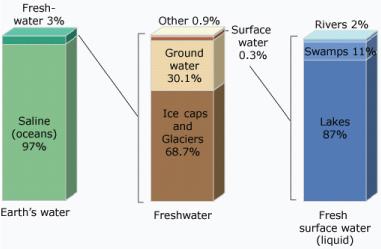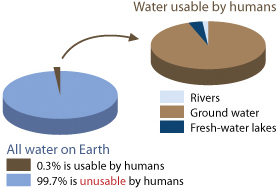
Figure 7.1.1, Distribution of Earth's Water.
(”Where is Earth's Water Located?” United States Geological Survey,
Water Science for Schools.
http://ga.water.usgs.gov/edu/earthwherewater.html)
|

Figure 7.1.2, How much of Earth's water is usable
to humans? (”Where is Earth's Water Located?” United States
Geological Survey, Water Science for Schools.
http://ga.water.usgs.gov/edu/earthwherewater.html)
|
|
Where is Earth's water located and in what forms does it exist?
You can see how water is distributed by viewing Figure 7.1.1. The
left-side bar shows where the water on Earth exists; about 97
percent of all Earth's water is in the oceans. The middle bar
represents the other 3 percent, or the "other" part of the left-side
bar (that portion of all of Earth's water that is NOT in the
oceans). Most of Earth's freshwater, 77 percent, is locked up in
glaciers and ice caps, mainly in Greenland and Antarctica, and in
saline inland seas. Another 22 percent of Earth's freshwater is
groundwater. The right-side bar shows the distribution of the
"other" portion of the middle bar (the remaining 1 percent). Notice
how rivers make up less than four-tenths of 1 percent of this
remaining water—yet this is where we get most of the water for our
everyday uses!
|
How much of Earth's water is available for our uses? In what forms
does it exist? You can best see how water is distributed by viewing
Figure 7.1.2.
The left pie chart shows that 99.7 percent of all water (in
oceans, seas, ice, and atmosphere) is not available for our uses.
And of the remaining 0.3 percent (the small brown slice in the top
pie chart), much of that is out of reach. Considering that most of
the water we use in everyday life comes from rivers (the small light
blue slice in the right-side pie chart), you can see that we
generally only make use of a tiny portion of the available water
supplies. The right-side pie shows that the vast majority of the
freshwater available for our uses is stored in the ground
(illustrated by the large brown slice).
|



